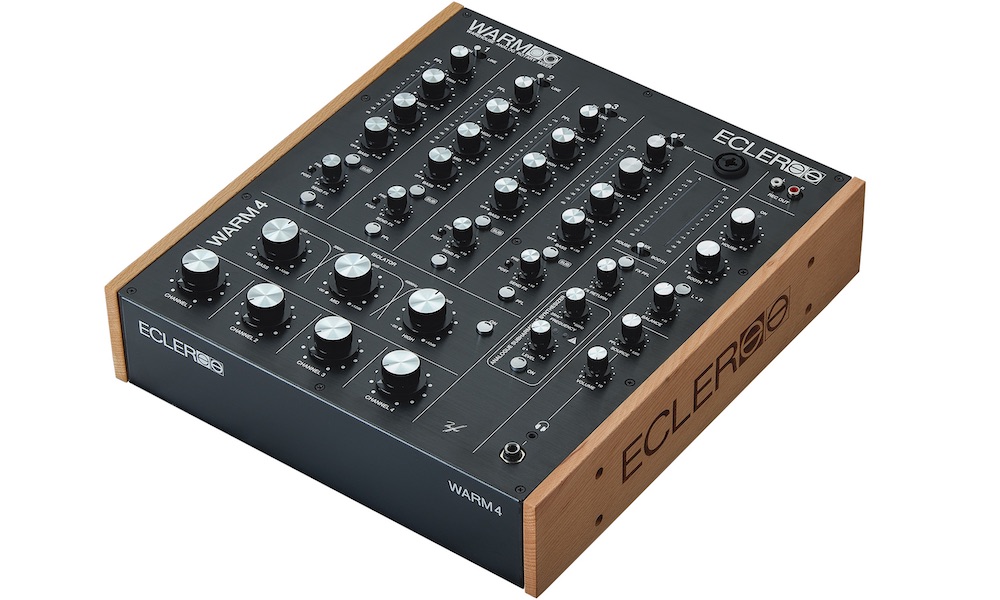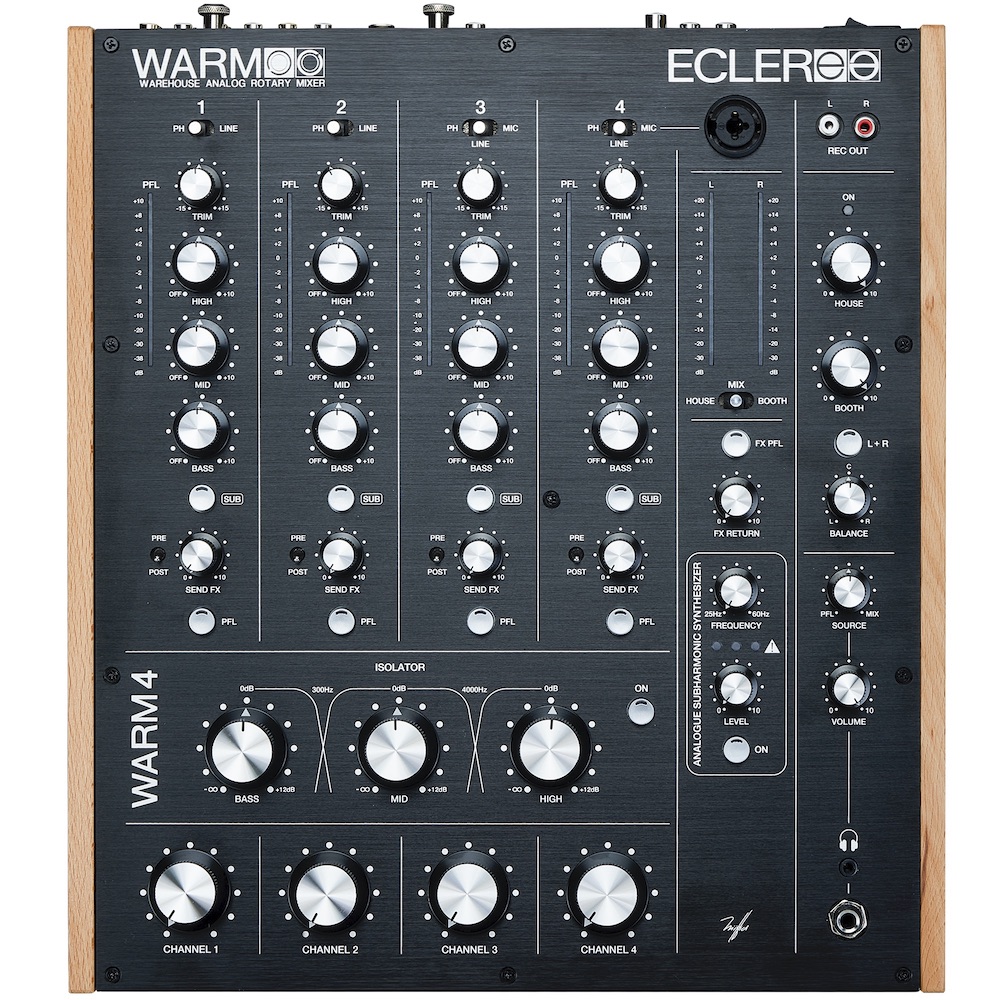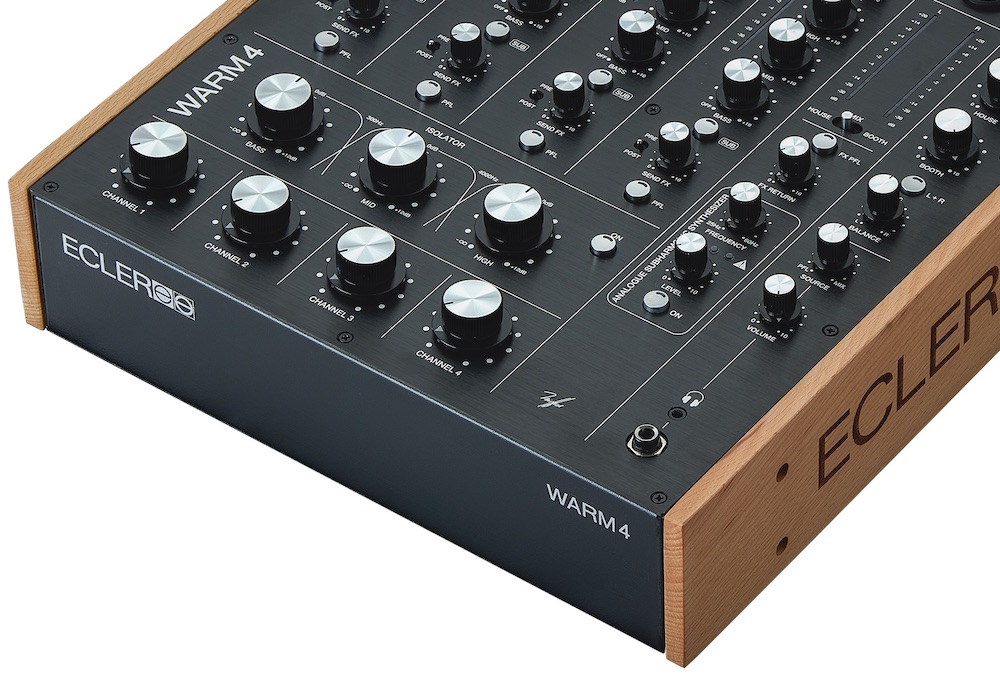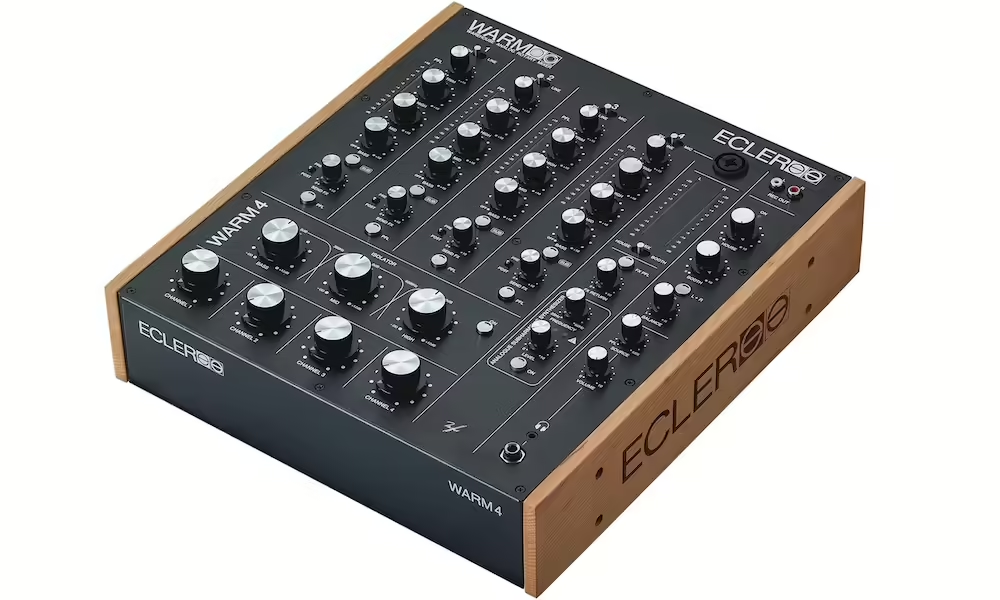Ecler WARM4 review | Juno Daily
Ecler’s new four-channel mixer features boutique rotary design, a unique subharmonic synthesiser and an appealing price tag. Greg Scarth finds out more.

Barcelona’s Ecler specialise in analogue sound, having been building mixers since the 1960s. When we tested their compact WARM2 rotary mixer last year, we were impressed by its smooth sound, carefully considered design and affordable price tag. The new Ecler WARM4 (Warehouse Analog Rotary Mixer) is a logical development, a four-channel version based on the same concept, coming in at an equally impressive £1,336. That might seem like a big jump up from the sub-£600 price point of the WARM2, but the larger WARM4 is a major upgrade, packing much more than just two extra channels.
Given that the WARM2 seems heavily based on the circuitry of Ecler’s Nuo 2.0 scratch mixer, you’d be forgiven for assuming that the WARM4 is a similar matter of repackaging the same kind of circuitry into a four-channel design. We’re told that’s not the case, though, and that the WARM4 is based on new and improved circuit designs. While there are similarities in terms of the overall look and features, the WARM4 is also clearly a significant step up in terms of build quality and feature set. We’ll get to the added features in due course, but the first impressions are very good, with a more solid feel to the panel-mounted pots than the slightly looser controls of the WARM2.
Given the major evolution from the WARM2, there are lots of extra features to get to grips with here. The four channels are broadly the same as those on the smaller model, with three-band EQ and pre- or post-fade aux sends, but with added PFL level meters for each channel and push buttons to engage the subharmonic synth (more of which later). All four channels can be either line or phono level, while channels 3 and 4 also offer two separate mic inputs (one on the back of the mixer, one on the top panel). Elsewhere, the three-band isolator section is familiar from the WARM2, but can now be engaged or bypassed using a push-button switch. The FX return can now be cued to the headphone mix, while booth monitoring can now be set to mono or panned.

In use, the WARM4 feels superb. Sound quality and specifications are all better than the WARM2 on paper, but the real comparison is with other four-channel mixers. Sonically, the WARM4 is a big step up from budget options like the Omnitronics TRM-422. While it might not quite match exotica like an ARS Model9500 for sheer punch and weight, that has to be taken in the context of their relative price tags. What the WARM4 offers is clarity, liveliness and an engaging sound. Summing is pleasingly clear, while the EQs and isolator are just as sweet as we’d expect having heard the broadly similar circuits on the WARM2.
The layout and ergonomics of the controls are also excellent, on a par with anything else on the market. One notable quirk is that it’s generally more common to find isolator controls at the top of the mixer, as on various ARS models and Rane’s MP2015, for example. Ecler have instead opted to position the isolator above the channel volume controls. This does break up the logic of the channel strips to an extent, but in practical terms it works well, with all four channel volume knobs and the isolator grouped closely together. The net result is that you can blend tracks with minimal hand movement, which feels intuitive once you get used to the layout.

A few eyebrows were raised about the inclusion of an ‘Analogue Subharmonic Synthesizer’ when the WARM4 was announced. To the best of our knowledge, the WARM4 is the first DJ mixer with a built-in analogue subharmonic generator, which might make it seem like a bit of a gimmick. There is a precedent here, though, and it’s a persuasive one. Legendary sound system designer Richard Long installed subharmonic synths such as the DBX Boom Box in iconic clubs including New York’s Paradise Garage. These analogue devices analyse the lower frequencies of a signal and then allows you to blend in a synthesised sub-bass signal an octave below the bass frequencies. The manual quotes Long and Alan Fierstein’s influential 1980 article State-of-the-Art Discotheque Sound Systems – System Design and Acoustical Measurement: “The DJ is not reproducing the works of Bach or Brahms as performed in a symphony hall but is instead playing music which was created in a multitrack studio under artificial conditions… By giving the DJ control over the extreme low and the extreme high end but not allowing him any control over the main full frequency range, he is allowed to create extremely exciting sound effects without affecting the overall balance.”
The sub synth can be activated on a per-channel basis by engaging the Sub buttons below the EQ. A dedicated On(/Off) button in the sub synth section also allows you to deactivate it entirely. The key is to adjust the sub frequency control to suit your track (the frequency range of 25 Hz to 60 Hz represents the fundamental frequency of the synthesised sub-bass signal, derived by analysing the 50 Hz to 120 Hz range). You can then blend the sub-bass in while monitoring the level with the three-LED VU meter, ensuring to dial back the sub level to avoid overpowering the music and potentially damaging speakers. The results are surprisingly organic, reinforcing the sub frequencies which are often quite weak on older records. More modern tracks might not need reinforcement if they’ve been produced and mixed with plenty of sub-bass, but the sub synth really comes into its own for playing older disco tracks, for example, alongside more modern house. The results are very effective on suitable tracks (and assuming you’re playing through a system which can reproduce low enough frequencies), and it’s certainly a nice option to have if you play older music from original vinyl pressings.

The WARM4 has clearly been carefully planned out for versatility and user-friendliness as well as sound. There are a number of small details which prove neatly designed in use. As previously mentioned, the isolator can now be bypassed, while a Balance control and ‘L+R’ stereo/mono button have been added in the Booth control section. Level monitoring is improved all round, thanks to those individual channel VUs and the option to set the main stereo VU to House, Mix or Booth. There are also more professional connections around the back than you’d find on the WARM2, with balanced XLR outputs for the Booth and House stereo signals. The only thing which might be a sticking point for some potential buyers is the lack of a split cueing option. That’s a matter of personal preference, but otherwise the WARM4 scores very highly for its feature set.
The WARM4 offers an impressively thorough feature set for its price point, but that certainly doesn’t mean Ecler have skimped on sound or build quality. The WARM4 would be a very appealing option even at twice its price point, which just reinforces how competitive that £1,336 price point is. We’d hesitate to use the word ‘bargain’ to refer to a DJ mixer with a four-figure price tag, but when compared to some of the more boutique options on the market the WARM4 really does seem like exceptionally good value. An outstanding rotary mixer for the money, well worth the upgrade from the WARM2 and capable of holding its own against rivals two or three times more expensive.
Greg Scarth
You may also like…


